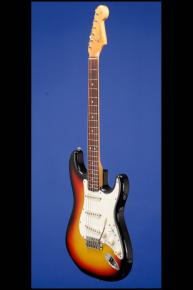A Near Mint 1965 L Series Stratocaster - One of the Cleanest Ever.
1965 Fender Stratocaster.
This is one of the the lightest Stratocasters that we have ever seen -- it weighs just 7.00 lbs. and has a nice fat nut width of just under 1 11/16 inches, a wonderful medium neck profile, and a scale length of 25 1/2 inches. One-piece alder body, contoured on back and lower bass bout, maple neck, and veneer Brazilian rosewood fretboard with 21 original medium frets and pearloid dot position markers. Small headstock with 'Transition' logo with "Fender" in gold with black outline, "STRATOCASTER" in black beside it, "WITH SYNCHRONIZED TREMOLO" in black below it, and four patent numbers "2,573,254", "2,960,900, "2,741,146" and "3,143,028" below that. . Single "butterfly'"string tree with nylon spacer. Individual "two-line" Kluson Deluxe tuners with oval metal buttons (stamped inside "D-169400 / Patent No"). Neckplate with four screws and serial number ("L80936") at the top. Three white plastic-covered staggered-height pole pickups with outputs of 5.40k, 6.14k, and 5.48k. Three-layer white plastic pickguard with eleven screws. Three white plastic Stratocaster knobs with ribbed sides (one volume and two tone) plus three-way selector switch. Six-pivot bridge unit with through-body stringing. The end of the neck is stamped "2 SEP 65 B". The light gray bottom pickups are dated "10-8-65," and the pots are dated "1376510" (CTS, March 1965). This incredible 'under-the-bed' guitar is in near mint (9.25) condition. There is a small area on the bottom of the treble horn where the guitar has rested in its case upon the 'spiral' guitar cord. This has left six very small and insignificant marks on the bottom surface of the treble horn. There is a very small area of surface loss on the bass side of the body and a few other very small and insignificant surface marks on the sides. There is almost no fret or fretboard wear and the guitar has been played very little. It has a typical 63-65 sound and in the 'middle' (2 and 4 positions) the Knopfler / Hendrix sound is quite breathtaking. Certainly one of the lightest, cleanest, freshest '65 Strats that we have ever seen. Housed in it's original Fender black hardshell case with black leather ends and dark orange plush lining (8.75).
The Stratocaster was launched in 1954 -- samples around May and June were followed by the first production run in October - and it was priced at $249.50 (or $229.50) without vibrato. This new Fender guitar was the first solid body electric with three pickups (Gibson's electric acoustic ES-5, introduced five years earlier, had been the first overall). The Stratocaster also featured a newly designed built-in vibrato unit (erroneously called a "tremolo" by Fender and many others since), to provide pitch-bending and shimmering chordal effects for the player. This was the first self-contained vibrato unit: an adjustable bridge, tailpiece, and vibrato system all in one. Not a simple mechanism for the time, but a reasonably effective one. Fender's new Stratocaster vibrato also had six bridge-pieces, one for each string, adjustable for height and length. The Stratocaster came with a radically sleek, solid body, based on the shape of the earlier Fender Precision Bass, contoured for the player's comfort, and with a yellow-to-black sunburst finish. Even the jack socket mounting was new, recessed in a stylish plate on the body face. The Fender Stratocaster looked like no other guitar around -- and in some ways seemed to owe more to the contemporary automobile design than traditional guitar forms, especially in the flowing, sensual curves of that beautifully proportioned, timeless body.












